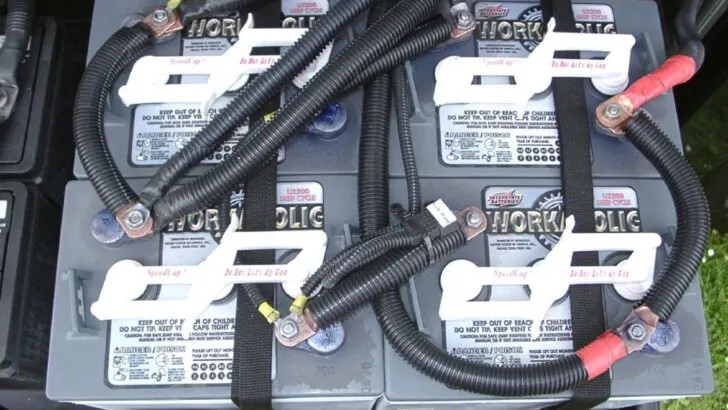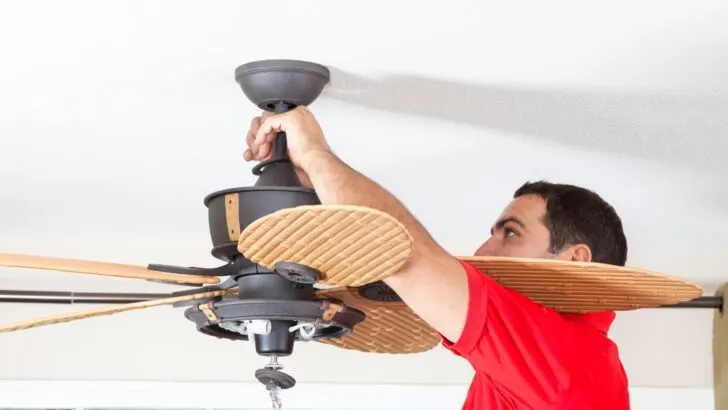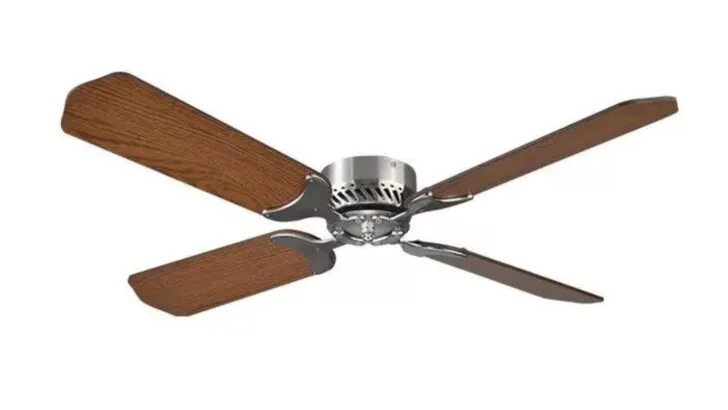If you’ve ever spent a summer camping in an RV, you understand the importance of finding ways to stay cool even when you’re not connected to shore power or generator power. One option you may not have considered is a 12V RV ceiling fan.
In previous posts, we’ve looked at RV roof vent fans and portable camping fans. In today’s post, we’re looking at 12 volt RV ceiling fans as another way to keep the breeze flowing in your RV’s living area or bedroom even when running on battery power.
What Is a 12V RV Ceiling Fan?
An RV 12-volt ceiling fan is similar to any ceiling fan that you might find in a sticks & bricks house in that it’s installed on the ceiling for the benefit of circulating air overhead. However, one significant difference between a home ceiling fan and a 12V RV ceiling fan is the voltage at which they operate (12V DC vs. 120V AC).
While you can install a regular 120V home ceiling fan in an RV depending on the height of your ceilings, the amount of space you have, and the weight of the fan, you’d only be able to run the fan when connected to shore power or generator power, or through the use of an inverter.
With a 12V ceiling fan for RV use, however, you can run the fan directly from your rig’s house battery power, even if you don’t have a generator or inverter.

Whether you’ve got a single house battery or a bank of several, you need to be mindful of conserving power when you’re running your 12V appliances when you’re not connected to shore power.
So, if you’d like to be able to run an RV 12 volt ceiling fan when you’re boondocking without an inverter or shore or generator power, a 12V ceiling fan might be a great option for you.
A regular ceiling fan might work for you if you’re always connected to shore power when you camp. Using an inverter, you could even run a regular 120V ceiling fan on battery power. However, this would deplete your battery bank faster, as converting 12V DC to 120V AC through the use of an inverter involves inherent inefficiencies.
A 12V DC ceiling fan will run directly off the RV’s house battery bank like an RV roof vent fan. However, it’ll perform a bit differently.
While your RV roof vent fan (installed through the roof of your rig) moves air into and out of the RV from/to the outdoors, a ceiling fan simply circulates the air inside the room. The breeze it provides will help keep you feeling cooler, especially if it’s mounted over the bed and you need cooling at night.
Things to Consider Before Installing a Ceiling Fan In Your RV
You’ll want to consider a few things before deciding to install a ceiling fan in your RV.
Power
As with all items that require power in an RV, you’ll need to consider whether you have sufficient power available to run a ceiling fan for the duration of time you expect to need it.
For example, many people install a 12V ceiling fan in the bedroom of their RV to keep cool at night. In this case, you’d want to make sure you have sufficient house battery power to run your ceiling fan through the night.
When you’re shopping for a ceiling fan, be sure to take note of the power consumption of that particular unit. Then, consider the amount of battery power you have to spare based on your general daily use of 12V power when you’re camping.
If you’ve got an RV solar system, consider how long it takes to replenish your battery bank in full sun, low sun, and no sun before adding another appliance that’ll draw power from that bank.
You’ll also want to be sure you have access to 12V power where you plan to install the fan. A nearby light fixture can be a good place to tap into power, as long as the fuse and wiring is rated high enough to handle the load from the fan’s motor.
Note: Don’t expect that a 12V ceiling fan is going to perform exactly like your 120V ceiling fan at home does. 12V fans work somewhat less vigorously and may produce a lighter breeze than you expect, so you’ll want to keep that in mind.
Size
There’s limited space in an RV, so be sure to carefully measure the area where you want to install a ceiling fan and purchase yours accordingly.
Headroom is generally less than in a sticks-and-bricks house, so make sure there’s room to walk under the fan. If there’s a slide-out in the area where you’d like to install the fan, be sure the slide and its operation won’t interfere with the placement of your fan.

When choosing a ceiling fan for RV use, you need to consider the unit’s weight, diameter, and height more than in a sticks & bricks house. A typical home ceiling fan like this one won’t work in most RVs.
Weight
Weight is generally a concern for most RVers because we need to keep the weight of the rig within its limits. However, there’s another potential weight issue to consider in this case.
The ceilings of RVs aren’t constructed like those in a sticks & bricks house. Many RV ceilings are made of thin plywood, styrofoam, and insulation. Choosing a lightweight RV ceiling fan is important from this perspective as well.
And if you’re considering installing a 120V traditional home ceiling fan in your RV to run while you’re connected to shore power, be very cautious regarding the weight of the fully installed fan. 12V RV ceiling fans are generally lighter than home ceiling fans you’ll find in the average big box store.
Drop
By “drop” we’re referring to height — how low the ceiling fan will hang. The average ceiling height in an RV is considerably lower than ceilings found in static homes. Most RV ceilings (other than tall 5th wheels) are no taller than seven feet, and many aren’t even that high. In fact, there really aren’t all that many RV ceiling fans made for just this reason.
You don’t want a ceiling fan that’ll have its blades turning at a height of 5 – 6 feet for obvious reasons.
So consider the drop of any RV ceiling fan you’re considering. In most cases, you’ll want a low-profile fan so it takes up as little vertical height as possible.
If you’ve got low ceilings in your rig, some fans mount flush to the ceiling. Generally called “hugger fans”, they’ll “hug” the ceiling so the blades won’t hang low, but you need to also be aware that they’re not as effective in terms of circulating the air and providing a breeze. And if your ceilings are really low, there may still not be enough safe clearance for your head.
Operation
Finally, you’ll want to consider whether you’d like to have an RV ceiling fan with a remote control option. This may not be important to you if you’re installing the fan in your general living space. You may not mind having to turn the fan off and on manually.
However, if you’re installing a ceiling fan in your RV’s bedroom, you may prefer a unit with a remote control so that you can turn the fan off and on from your bed.
Five 12V RV Ceiling Fans For Your Consideration
Let’s look at some of the 12V RV ceiling fans available today.
Camper Comfort E17
This 36″ 12V ceiling fan from Camper Comfort runs at 20 Watts and 2 Amps.
This unit has four black 13 1/2″ blades, and the base has a brushed nickel finish. The fan has full dimensions of 34″D x 34″ W x 41.5″H. This reversible 12V RV ceiling fan offers four speeds (25%, 50%, 75%, and 100%). It’s operated by a wall switch, which is included with the fan.
- 12V DC, 20 Watts, and 2 Amps
- 4-speed (25%, 50%, 75%, and 100%)
LaSalle Bristol 410TSDC42BNWH
This is a 42″ ceiling fan with white blades made from painted engineered wood with a white nickel base. It draws around 4 amps and has a reversible brushless motor.
The fan blades of this unit drop down only 5 1/8″ and the entire unit weighs 6 pounds. For these reasons, the 12V fans from Lasalle Bristol can generally be mounted in most RVs.
This particular unit has dimensions of 42″D x 42″W x 5″H and is operated via a wall switch (included).
LaSalle Bristol 36″ Oak/Cherry Ceiling Fan
Lasalle Bristol also produces a 36″ RV ceiling fan in a brushed nickel finish with oak/cherry blades. It has a 4-speed reversible motor and offers the same 5 1/8″ drop as the 42″ unit featured above. This fan is available here at Dyer’s Online.

RecPro 36″ RV Ceiling Fan
Measuring 34″ wide by 4 1/4″ high, this 12V RV ceiling fan’s mount sits up close to the ceiling. It has a 34″ diameter, is 4.25″ high, and weighs in at 8.5 pounds.
This is a 20W unit that runs at 2 amps, and the direction of the four fan blades is reversible. The bases of these fans have a brushed nickel finish and the blades are available in a variety of colors including black, oak, cherry, and white.
Operated by a wall switch, RecPro RV ceiling fans run at four speeds.
- Measuring 34" wide by 4 1/4" high, this 12V RV ceiling fan comes in a variety of colors that each look terrific. The brushed nickel finish on the base...
- The brushed nickel ceiling fan is also built with RVs in mind. The lower profile of the fan (the mount sits right up against the ceiling rather than...
Global Electric 36″ Non-Brush Ceiling Fan
This 36″ RV ceiling fan from Global Electric has a brushed nickel base. Blades are available in a dark cherry or light cherry wood finish. This is a brushless fan, which is meaningful for a couple of important reasons.
First, its electricity usage is only 1 amp (12Watts) which is about 1/3 of many other ceiling fans which is great for conserving your house battery power. A brushless motor is also typically very quiet compared to other types of fan motors.
This is a flush-mount fan that’ll sit up close to the ceiling. It offers six speeds as well as thermal overload and overheat protection. The drop is 6″ from the ceiling, and the entire unit weighs 7.15 lbs.
This RV ceiling fan is operated via the included wall switch, from which you can control the fan’s direction and speed.
No products found.
Do You Have a Ceiling Fan In Your RV?
We’ve read some reviews from RVers who installed one ceiling fan in the living space of their rig and liked it so much that they installed a second in the bedroom. If you’ve installed a ceiling fan in your rig, we’d love to hear which fan you chose and how effective you’ve found it to be. Let us know in the comment section below.
Free RVing Tips, Tricks, Reviews, Giveaways & More
Subscribe to our daily newsletter! We’ve been full-time RVers for 20 years (!) and share everything we’ve learned about RVing in our daily blog posts. Join our online community to receive a wealth of great RVing knowledge delivered right to your inbox.
Whether this is your first time on the road or you’re a seasoned full-timer, you’ll love the wide range of RVing topics we cover. Don’t miss a single article or any of our famous RV gear Giveaways — Subscribe today!





Al
Friday 12th of January 2024
Thanks for your article on ceiling fans.One thing you missed is the ceiling fan from BJ RV & marine.I installed it in our motor home.The special features about them is there size,28 inches but the best thing is it is remote controlled. This makes install much easier. I was able to grab power from a ceiling light rather than having to fish wires down the wall and install a switch. Have used it for a year and it works great and is quiet. Hope this helps. Al
TheRVgeeks
Monday 15th of January 2024
Thanks, Al. We'll have to check it out!
Jim & Gen
Sunday 17th of September 2023
We have a 2003 Newmar Dutch Star. Our ceiling is not very tall but we bought this 12v hanging fan for our room. Our grandson loves it as he is interested in stars. Our Daughter uses it in her tent when she comes and camps with us — https://amzn.to/3LrVPKS